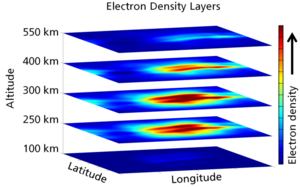IMPC Concept
The "Ionosphere Monitoring and Prediction Center" (IMPC) developed and operated by DLR provides a near real-time information and data service on the current state of the ionosphere, related forecasts and warnings. Being the successor of the well-established Space Weather Application Center – Ionosphere (SWACI), IMPC now provides considerably improved ionosphere weather information and forecasts and additionally provides the SWACI long term data archive.
Objectives
The performance of radio systems used in space based communication, navigation and remote sensing is affected by the ionospheric variability. Moreover, ionospheric disturbances may degrade the accuracy, reliability and availability of Global Navigation Satellite Systems (GNSS), such as GPS and the future civilian European system Galileo. Threats due to the ionosphere can be mitigated with the help of IMPC services such as forecast and warnings of ionospheric disturbances.
Data, Products and Dissemination
Well established ground and space based GNSS measurements offer a unique chance to permanently monitor the electron density and its structure of the ionosphere-plasmasphere system. This is the main data source for IMPC products like the Total Electron Content Maps and products describing ionospheric perturbations like scintillation indices and Rate of Change of TEC index. Next to this, IMPC also generates scintillation products and relative TEC from Beacon satellites. In cooperation with parner institutes providing ionosonde measurements, IMPC is providing combined ionosphere products like the equivalent slab thickness. IMPC products are disseminated via this website and users can subscribe for receiving warning messages via e-mail.
IMPC Network
Data exchange and international cooperation are crucial for operating the IMPC. Therefore, the IMPC is involved in the Space Weather European Network (SWENET) of ESA and maintains intensive relationships to plenty of European and international facilities in the space weather domain. In particular there is a close cooperation between the IMPC and the NOAA Space Weather Prediction Center Boulder (USA). Furthermore, IMPC products and expertise are involved in numerous national and international research-, infrastructural- and educational projects funded by EU, ESA and federal agencies.
- Astrophysikalisches Institut Potsdam (AIP), Potsdam
- AXIO-NET GmbH , Hannover
- Bundesamt für Kartographie und Geodäsie (BKG), Frankfurt
- Ernst-Moritz-Arndt-Universität (EMAU), Greifswald
- ESA (SWENET)
- Finnish Meteorological Institute (FMI), Helsinki
- Forschungsgesellschaft für Angewandte Naturwissenschaften e.V., FKIE, Wachtberg
- GeoForschungsZentrum (GFZ), Potsdam
- Hochschule Neubrandenburg - University of Applied Sciences
- IEEA/ Courbevoie, France
- Institut für Astrophysik, Georg-August-Universität Göttingen
- Institut für Atmosphärenphysik (IAP), Kühlungsborn
- Institut für Meteorologie, Universität Leipzig
- NOAA Space Weather Prediction Center (SWPC), Boulder
- Norwegian Mapping Authority (NMA)
- Technische Universität Berlin/ Institut für Geodäsie und Geoinformationstechnik
- Zentralstelle SAPOS
- TrigNet (South Africa)
- UNAVCO
IMPC Development
Fundament of the IMPC development is a solid and continuous research activity in ionospheric science. The IMPC research addresses amongst others ionospheric perturbation detection, modelling and forecasting, mapping errors, higher order errors in precise point positioning, empirical and physical modelling and 3D electron density reconstructions. IMPC aims to become the European Expert Center forionospheric weather.
IMPC Facilities
Data from several facilities within DLR are used in order to enable the IMPC in providing reliable space weather products and warnings in near real time.
Experimentation and Verification Network (EV-NET)
Small scale ionospheric disturbances may cause severe radio scintillations of signals transmitted from global navigation satellite systems (GNSS). Consequently, small scale plasma irregularities may heavily degrade the performance of current GNSS such as GPS, Glonass or Galileo. Therefore DLR operates an own high rate 50 Hz GNSS receiver network for scintillation measurement from high latitudes down to equatorial regions hostet at partner institutions.
Global Ionospheric Flare Detection System (GIFDS)
GIFDS has been established at DLR to measure sudden ionospheric disturbances (SIDs) in the D-layer Ionosphere caused by solar flares. Since strong solar flares can disturb communications as well as navigation signals users of such systems can be informed of potential performance degradation of their system.
Reception of solar wind data (DSCOVR)
DLR is the only European member of the Real Time Solar Wind (RTSW) observation network, engaged in the data transfer and analysis of NASA’s Advanced Composition Explorer (ACE) and the Deep Space Climate Observatory (DSCOVR).






